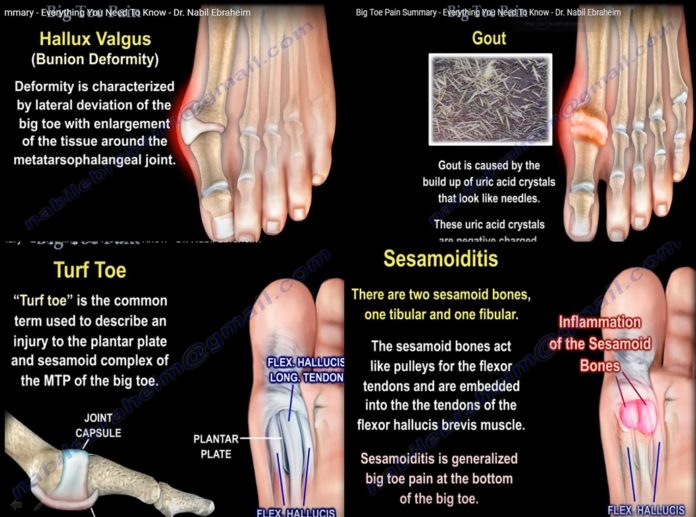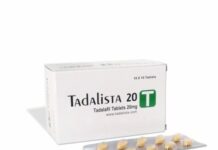Overview
If you’re having pain in your big toe, you’re probably eager to figure out what’s causing it so you can find relief. It’s essential that you get to the root cause of your toe pain so you can take appropriate steps to heal.
The hallux metatarsophalangeal (MTP) joint connects the base of your big toe to the head of the first bone on the top of your foot. It also connects to the two tiny bones underneath this bone.
This joint is often affected by pain and injuries that can interfere with your daily life, making simple activities difficult. Activities involving movement and weight-bearing actions cause the most stress.
It’s important to see your doctor whenever you have any new pain, but here are some common ailments that could be causing your big toe discomfort.
Bunion | Bunion
A bunion is medically referred to as hallux valgus. It’s a toe deformity that occurs when the big toe joint angles in toward the second toe. A knobby, bony bump develops on the side of your foot below your toe joint due to misalignment.
Bunions cause pain, irritation, and swelling at the base and side of your toe joint. Calluses and thick skin may form under your first and second toes.
Bunions can be caused by arthritis, standing for extended periods of time, and shoes that don’t fit properly. Hereditary bone structure of the foot can also play a role, especially if you have flat feet.
You can wear special pads or orthotic inserts for shoes to provide support and cushioning. Wearing toe splints at night can help to realign your toes. To reduce pressure, your doctor may use padding and tape to move your foot into alignment.
You can take nonsteroidal anti-inflammatory (NSAIDs) medications such as ibuprofen or aspirin to reduce pain. Natural anti-inflammatory options include ginger, fish oil, and curcumin.
Do stretching exercises for joint flexibility and ice the affected area for 20 minutes at a time, especially before and after workouts. Surgery is sometimes needed to remove the bump and reposition the bone.
Ingrown toenail
Ingrown toenails are most likely to affect your big toe. They occur when the edges or corners of your toenail grows into the skin on the side of your nail. This causes pain, swelling, and tenderness, especially when you put pressure on the toe.
Ingrown toenails have many causes, including foot hygiene issues, injuries, and pressure from shoes. Activities that cause you to put pressure on your feet for extended periods, such as ballet, soccer, and football, can make ingrown toenails more likely.
Some people are genetically inclined to get ingrown toenails, as are people who have irregular, curved toenails.
Cut your toenails straight across to prevent them from angling into the skin. Reduce pressure to your toes by wearing comfortable shoes. Seek medical attention immediately if you show signs of infection such as pus, warmth, or redness.
Home remedies for ingrown toenails include soaking your feet in warm water a few times per day. Use a cotton ball soaked in olive oil to gently push the skin away from your toenail.
Pain relievers such as acetaminophen and ibuprofen can also help. You may use topical steroid creams or antibiotics to prevent infection. Severe cases may require surgery.
Turf toe
Turf toe is a sprain that affects the soft tissue and ligaments at the base of the big toe joint.
Turf toe causes swelling, discoloration, and sharp pain, which limits mobility. It’s caused by too much stress on your toe while flexing your foot.
It’s either the result of force, which is felt immediately, or a repetitive injury that develops slowly over time.
Turf toe can be treated with NSAIDs or corticosteroid injections to help manage pain and inflammation. Your doctor may give you stretches to increase strength and mobility, or you may be referred to a physical therapist.
Wear shoes with proper support or inserts to prevent future injuries.
Rest your foot as much as possible. Ice your toe a few times per day. Buddy tape the affected toe, use shoe cushions, or wear a compression bandage. Crutches or a walking cast may be needed. Surgery may be needed in severe cases.
Arthritis
Arthritis is the degeneration of the cartilage that cushions bones and joints. It commonly affects the big toe, which is known as hallux rigidus.
Symptoms include pain, swelling, and stiffness, especially when walking or standing.
Arthritis of the toe can be due to poor foot alignment as well as general wear-and-tear of the cartilage.
Reduce pain and inflammation by wearing shoes with a stiff sole or those that bend at the big toe joint. You can take NSAIDs or have corticosteroid injections to reduce pain and inflammation. Physical therapy or stretching may be beneficial. Surgery is needed in extreme cases.
Sesamoiditis
Sesamoiditis is an inflammatory foot condition that affects the two tiny bones under the big toe joint. These are known as sesamoids, which are bones embedded in tendons. The tendons and surrounding tissues are also affected, making it difficult to straighten or bend your toe.
Symptoms include:
- pain
- inflammation
- bruising
Sesamoiditis occurs from acute trauma or overuse.
It can be treated by taping the affected toe so that it bends downward. Orthotic devices or shoe cushions may also help. Crutches or a walking cast can relieve pressure if complete immobilization is necessary.
Your doctor may recommend NSAIDs or corticosteroid injections to relieve pain and inflammation. Sometimes surgery is needed, especially if there are fractures to the sesamoids.
Gout
Gout is a metabolic condition that commonly affects the big toe joint. The medical term for this is podagra.
Gout is a form of arthritis caused by a buildup of uric acid in the blood that crystallizes and builds up in joints. This can be due to diet and lifestyle factors and certain medical conditions. Medications such as diuretics and cyclosporine can increase your risk of gout.
Symptoms include intense pain, swelling, and tenderness around your big toe joint. The area may be inflamed, hot, and appear red. Sometimes symptoms are sudden and severe, especially at night.
Take NSAIDs to ease pain and inflammation. Your doctor may prescribe additional specific medications for treatment of the uric acid deposit and production or steroids.
To reduce uric acid buildup, follow a healthy diet that includes plenty of vegetables, whole grains, and fiber. Reduce your intake of red meat and seafood. Avoid drinks containing alcohol or sugar, and increase your water intake.
Sprained or broken toe
A sprained or broken toe are common causes of toe injuries. Injury to a ligament results in a sprain, whereas a broken toe affects the actual bone.
If you sprain your toe, you may experience pain around your entire toe. This may be accompanied by bruising, swelling, and tenderness. You may have difficulty moving your toe.
Symptoms of a broken toe include:
- throbbing pain
- bruising
- swelling
One sign of a broken toe is that it’s dislocated and sticking out at an odd angle. Pain will be so severe that it’ll be difficult to put any weight on your foot. You’ll feel this pain at the exact area of the fracture as opposed to pain from a strain, which you’ll feel all over the affected area.
Both injuries are caused by trauma or hyperextension to the toe and take several weeks to heal. Treatment may involve splinting or buddy taping the affected toe.
Rest as much as possible and avoid putting pressure on your foot. Wear shoes with padding or a stiff sole for protection and support. Apply a cold compress a few times per day and take NSAIDs to relieve pain and inflammation.
Severely broken toes may require a walking cast or surgery.
Options for pain relief
Natural options for pain relief include:
- turmeric
- cloves
- willow bark
Acupuncture, meditation, and massage are additional natural treatment options. Fatty acids such as omega-3s and gamma-linolenic acid (GLA) may be useful in treating joint stiffness and pain from arthritis.
NSAIDs and corticosteroid injections are often good options for pain and inflammation. You may also want to give hot and cold therapy a try. Simply apply a hot or cold compress to the affected area a few times daily for 15–20 minutes at a time.
Rest as much as you can and elevate your foot when possible. Use a compression bandage if it’s appropriate.
The takeaway
Big toe pain is something to pay attention to, treat, and monitor accordingly.
Treat your body with care and address any painful or unusual symptoms as soon as they arise. Keep your eye on your toe even after it starts to improve to make sure you’re healing properly.
Speak to your doctor if your foot pain is interfering with your daily activities or worsens over time. Your doctor can help you to decide on the best treatment plan.







